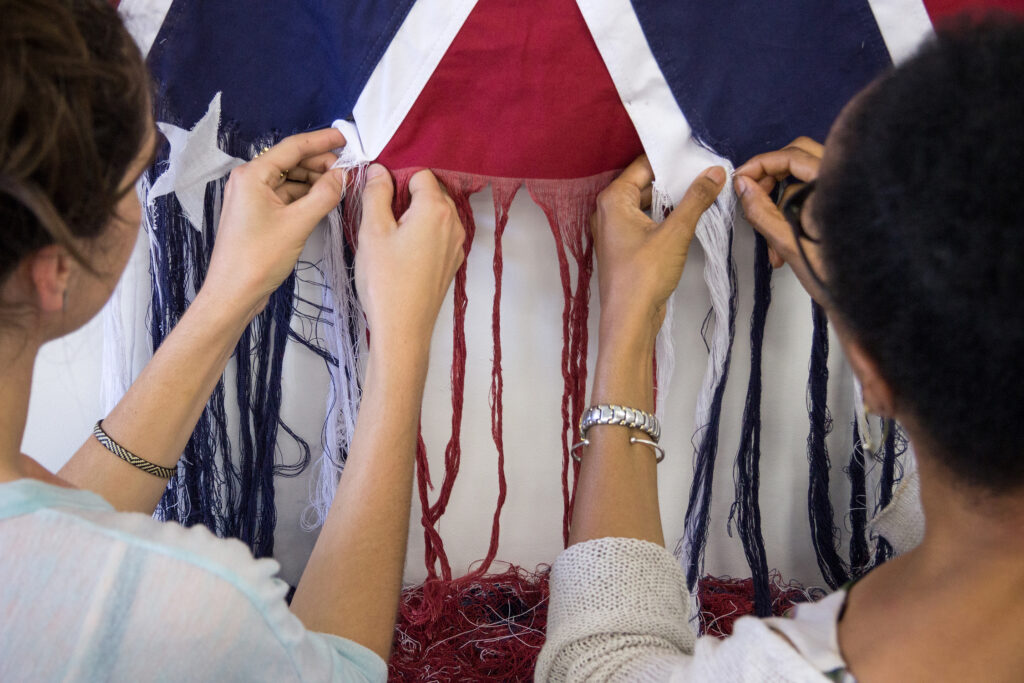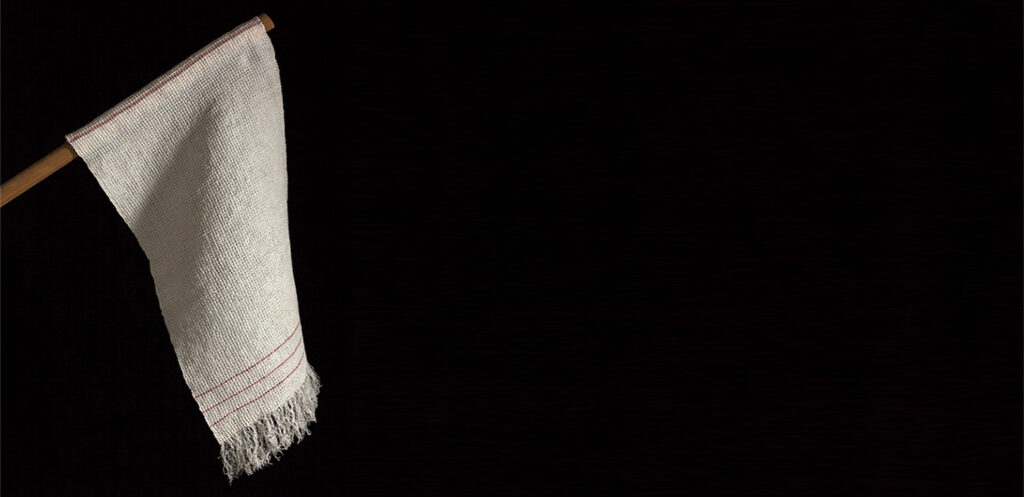
The Monumental Sonya Clark
Consider the following virtual connection between two thought leaders across time and space. In the summer of 1965, the year after winning the Nobel Peace Prize, Dr. Martin Luther King, Jr. was conferred an honorary Doctorate Degree in Humane Letters from Oberlin College. Dr. King’s commencement address was “Remaining Awake Through a Great Revolution.” The following sentence is one of the most frequently quoted from his remarks of the day among the many oratorical turns-of-phrase he wrote and spoke in his life.
“All I’m saying is simply this, that all life is interrelated, and we are all caught in an inescapable network of mutuality, tied in a single garment of destiny.”[1]
For many people then and now, Martin Luther King’s view of human destiny as a garment whose warp and weft is made from the whole of humankind has been commonly dismissed as an aspirational abstraction by a dreamer of the utopian kind, blind to the practical realities of human relations.
In the spring of 1967 Sonya Clark was born in Washington, D.C. Her life embodies the inter-relationships of human life Dr. King depicted in his commencement speech as the daughter of a father from Trinidad and a mother from Jamaica with traceable roots in Scotland, complete with a family tartan as one of the billions of threads in the garment of human destiny. From these roots, Clark has among other dimensions of her humanist project routinely brings the textile metaphor woven by Martin Luther King, Jr, into visual and material form, and contributes to the conversation about the inter-relatedness of human life.
We have been greatly benefitted by her attention to the bonds between and bondage of peoples from Africa, the islands of the Caribbean, South America, and the United States of America through the transatlantic slave trade. But humanism is but one of many cultural conversations Clark virtually contributes to through her rich intersectional curiosity.
Beyond her role as Professor of Art at Amherst College, Sonya Clark is a contributor to a virtual conversation at the intersection of contemporary art and public education that includes the artist Luis Camnitzer. Since 2009 Camnitzer has brought A Museum is a School, his traveling series of text-based site-specific installations, to art museums around the world. Camnitzer declares the museum as a site for enlightenment through placement of three lines of text on the front of each museum. The Museum is a School. The Artist Learns to Communicate. The Public Learns to Make Connections. These declarative sentences shift the context of the museum and its contents from a muted mausoleum for objects and images to a vigorous, spirited, dynamic space for connection, collaboration, and communication. [2]
Clark’s vigorous, spirited, and dynamic production of knowledge and meaning at the intersection of the visual and liberal arts is a seamless merger of her considerable reservoir of social and scholarly literacies, as well as her solitary and collaborative artistic practices. Like Camnizer’s vision of the museum, what continues to emerge through the work of Sonya Clark is no less than a school of thought. Each public encounter with her thinking in the white cubes of the museum and gallery space is a master class in expression, communication, and aesthetic force that instructs and edifies. So exactly what knowledge do we have as an audience to what she calls her authentic obsession? What connections have we made as “the public?” What have we learned?
We now know and can see better than we did in middle school how DNA is an individual and collective fact—like the cloth in the garment of human destiny. We now know in expansive ways that there is meaning in materials and objects. We cannot look at combs, cloth, wood, metal, gold, sugar, hair, and ink in the same ways.
We have learned about the cultural bridge of Pitchy-Patchy in Jamaica between the Egungun in Nigeria. And we know how the color white symbolizes wisdom in Yoruba iconography. Through the numerical competence of Sonya Clark, we now know the length of a single strand of locked or felted hair at one hundred years of human life equals thirty feet based upon her calculations. Her numeracy and uncommon curiosity about the commonality of roots, cells, and branches has taught us that the number of family members over ten generations amounts to exactly 1,025 people.
Through Clark’s interest in the roots and routes of language and their intersections with the language of fibers our vocabularies have expanded to understand the shared etymology of the words text and bead with textile and prayer. Sonya has the unique distinction of convening over five thousand people from over 35 nations to collectively bead amulets for written prayers that are otherwise silent and to know the power in such small packages and the materials used to make them.
We also know and can see the hybridization of material culture between Africa and Europe in so many of her works and in material culture beyond her work. We also know through her teaching that hair is a fiber, and the ways hair styling is ritualized from person to person, a conduit for sonic language, and a sculptural practice across the Black diaspora, especially between Nigeria, Jamaica, Trinidad, Washington, DC. We have learned the ways hair braiders throughout the African diaspora are artists on and off the human head from the neck upwards as well as through their hands, and, by extension, the manual and mental labor of Black women globally—and especially in Richmond, Virginia.
The historian Khalil Gibran Muhammad once remarked during a conversation with journalist Bill Moyers that “history is all around us.”[3]
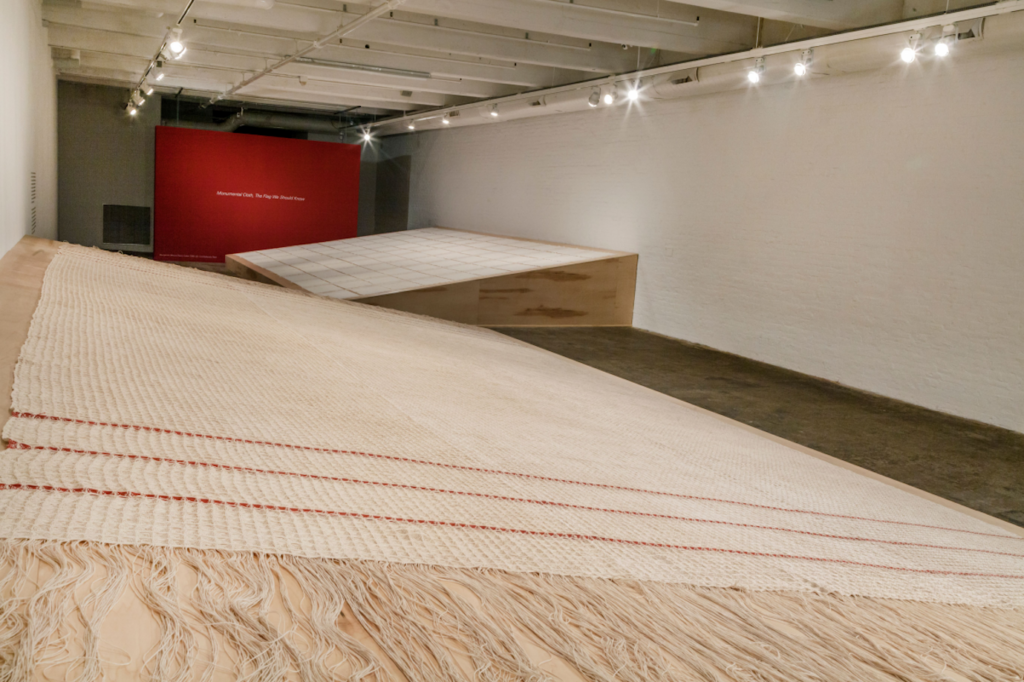
Through the remarkably innovative works Unraveling and Monumental Cloth: The Flag We Should Know, Sonya Clark brings a nuanced and necessary re-presentation and reframing of two historical symbols of the Confederate States of America from the past and the present; the more visible battle flag, and the less visible truce flag of surrender, an obscure under-exposed and under-discussed piece of fabric she discovered in the collection of the Smithsonian National Museum of American History.
Unraveling and Monumental Cloth boldly disrupt current and cyclical debates about the role, relevance, and place of monuments to white supremacy in the United States; especially in the aftermath of the tragic murders of nine Black members of Emanuel African Methodist Episcopal Church during Bible Study in Charleston, South Carolina in 2015. Through Unraveling and Monumental Cloth, She boldly challenges conceptions of what a monument is to include the cloth of the battle and truce flags of the Confederacy.
We are asked to recognize ideas, images, and ideologies as monuments as much as we recognize them as physical objects. Clark also asks us to question the sincerity and authenticity of the truce between the Union and Confederacy through General Lee and General Grant in 1865 on that April day in a courthouse in Appomattox, Virginia.
Unraveling and Monumental Cloth makes significant contributions to the over one hundred-and sixty-year-old conversation about the American Civil War as well as the debates over its causes and its aftermath. This conversation includes a host of American historians such as David Blight, James McPherson, Heather Cox Richardson among others. The questions and answers raised by Unraveling and Monumental Cloth also draw essential connections to the increased amplification of the symbol of the Confederate “Lost Cause” at a critical tipping point in the story of the United States.
There have been moments in various parts of this nation since 2016 that resemble scenes from The Birth of a Nation, the first feature length motion picture in history and nothing less than a cinema of white supremacist terrorism by director D.W. Griffith in 1915. The contemporary rhetoric of individual politicians and public policies of the eleven states of the Confederate States of America at their judicial and legislative branches of government recall the 19th-century view that democracy is the enemy of oligarchy and equality requires inequality in the United States of America especially at the intersection of race and rights.
I am reminded of the words of Alexander Stevens, Vice President of the Confederate States of America that “the cornerstone of this new [confederate] government” “. . . rests upon the great truth that the negro is not equal to the white man, that slavery, subordination to the superior race, is his natural and moral condition.”[4]
Clark invites us through Unraveling and Monumental Cloth, to participate in dismantling the white supremacist project through the ritual of unraveling the monument that has become the Confederate battle flag, but also question, who actually lost at the conclusion of the war between the states.
The boundless and intersectional curiosity reflected in the work of Sonya Clark is nothing less than monumental itself and we, the public will continue to grow and learn to make connections through the ideas that inform and inspire this visual, material, and media culture. Her intersectional thinking and engagement provide essential lessons for us all to learn as stewards of the planet, our selves, each other, and that “single garment” of our mutual destiny.
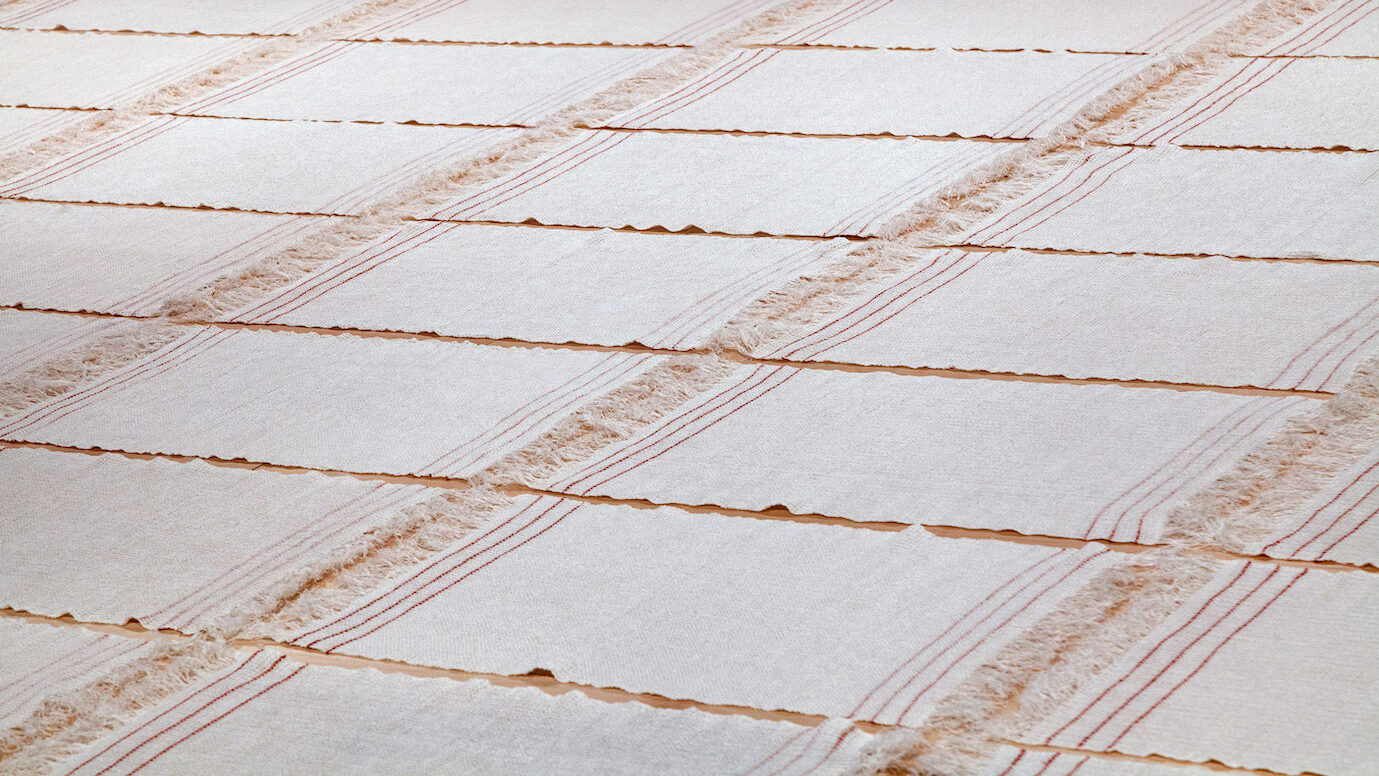
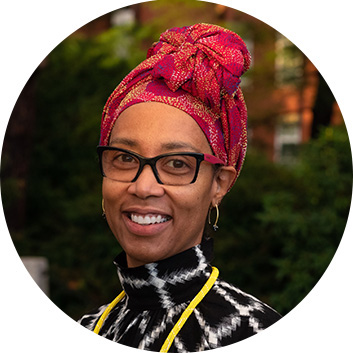
SONYA CLARK
Sonya Clark is a leading American artist and Professor of Art at Amherst College. Her work is exhibited in over 500 museums and galleries in the Americas, Africa, Asia, Europe, and Australia. She is the recipient of a United States Artists Fellowship, a Pollock Krasner award, an 1858 Prize, an Art Prize Grand Jurors Award, and an Anonymous Was a Woman Award. She has had the opportunity to make work alongside creative individuals at the Red Gate Residency in China, the BAU Carmago Residency in France, the Rockefeller Foundation Bellagio Residency in Italy, the Smithsonian Artist Research Fellowship in DC, the Civitella Ranieri Residency in Italy, the Yaddo Residency in NY, and the VCUarts Affiliate Fellowship at the American Academy in Rome. Most recently, she was an inaugural recipient of the Black Rock Senegal Residency Fellowship. Her work has been reviewed in several publications, including the New York Times, Sculpture, Art in America, Philadelphia Inquirer, Time Magazine, Italian Vogue, Los Angeles Times, Hyperallergic, Mother Jones, and many others.
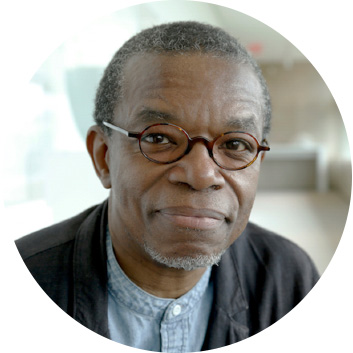
BILL GASKINS
From a professional base in photography and arts writing, an academic foundation in fine art, the history of photography, American Studies and the perspective of a citizen of the United States, the work of Bill Gaskins explores questions about photography and the portrait in the 21st century. A critical entry point for the viewer is his fascination with the myths of photography and American culture and representations of African American people. His approach to photography as both producer and critical spectator has garnered attention through commissions, artist residencies, grants, public lectures, solo and group exhibitions, exhibition catalogs and books.
Good And Bad Hair: Photographs by Bill Gaskins is his breakthrough monograph on the role of hairstyling and photographic representation in African American culture(s) that is also a reflection on the societal and transcultural role of hair, adornment and personal identity. As an artist, teacher, scholar, and essayist, Bill Gaskins’ artwork, teaching, writing, lectures and workshops examine race and visual representation, photography & the portrait, the history of photography, contemporary art and the politics of visual culture, media literacy, the evolution of university art education, and the artist as citizen.
As a professor of art, Bill Gaskins has taught at The Ohio State University, the School of the Art Institute of Chicago, the University of Missouri, the College of Art, Media & Technology and the College of Art and Design Theory and History at Parsons School of Design, and the graduate program in Media Studies in The New School for Public Engagement. Presently he is an Associate Professor in the Department of Art with a faculty appointment in the American Studies Program at Cornell University.
Bill Gaskins received his Bachelor of Fine Arts degree from the Tyler School of Art, a Master of Arts Degree from The Ohio State University, and a Master of Fine Arts Degree from the Maryland Institute, College of Art.
Edited by Samaa Abdurraquib
Samaa Abdurraqib is a writer and a poet living in Maine’s Midcoast. She is the editor of From Root to Seed: Black, Brown, and Indigenous Poet Write the Northeast (forthcoming). Her poetry can be found in Cider Press Review and Obsidian: Literature and Arts in the African Diaspora.
